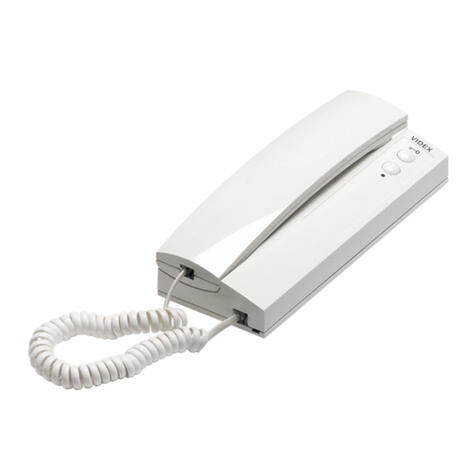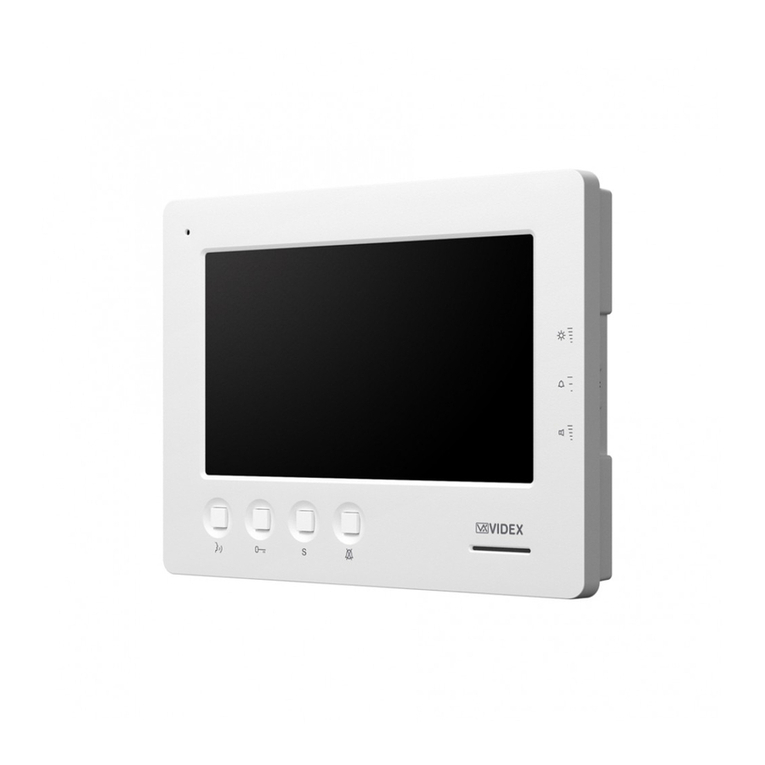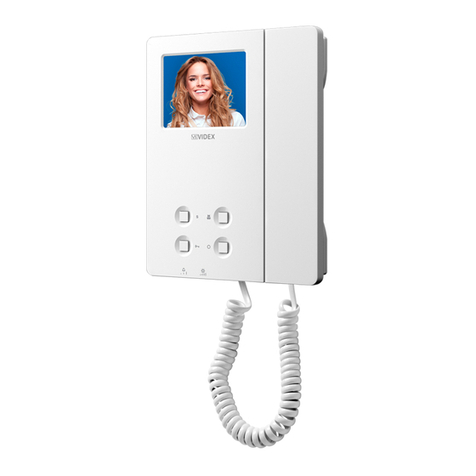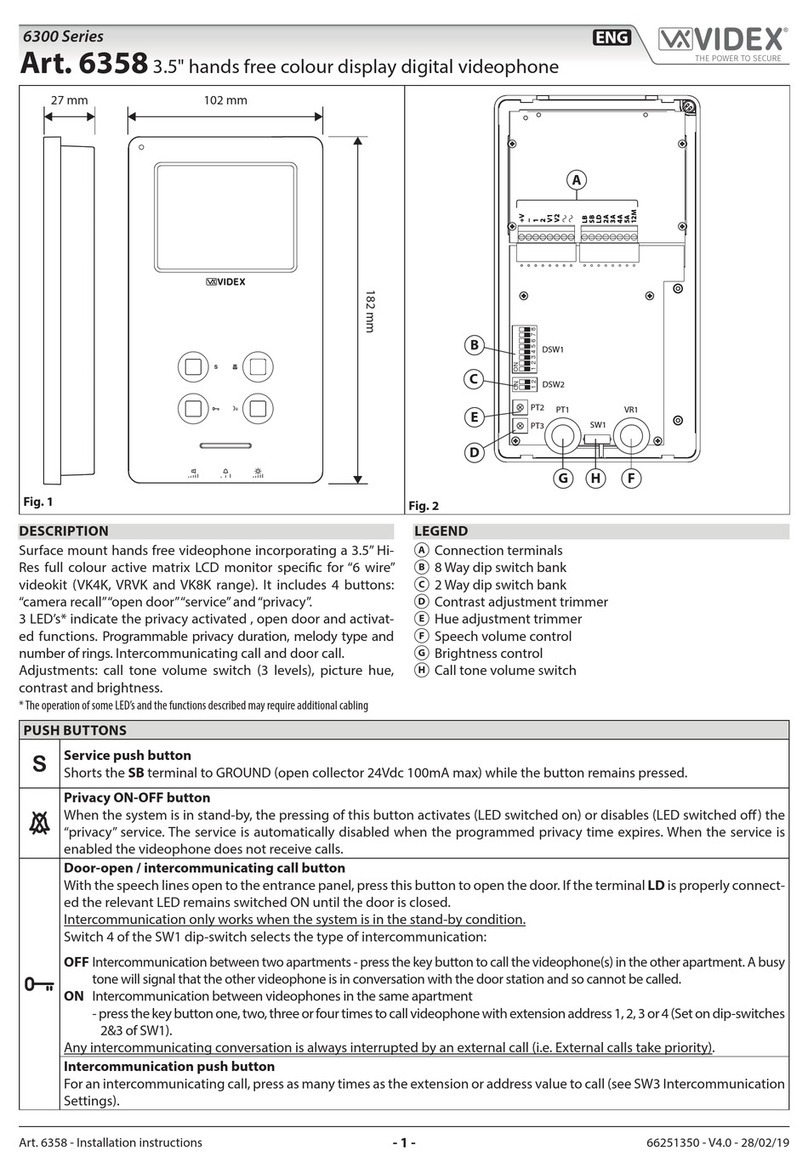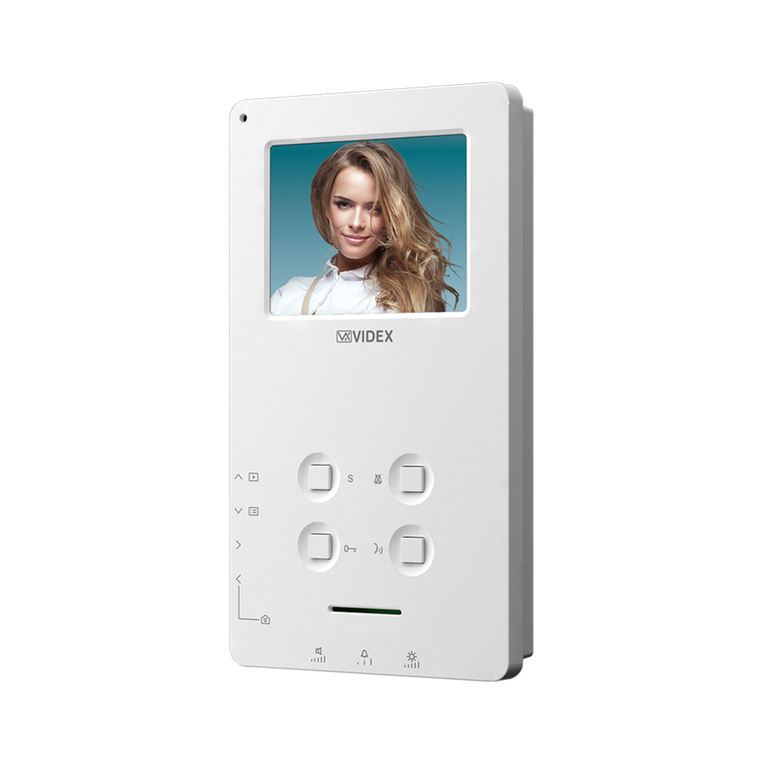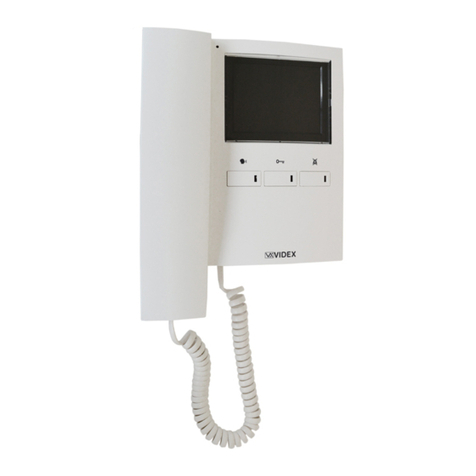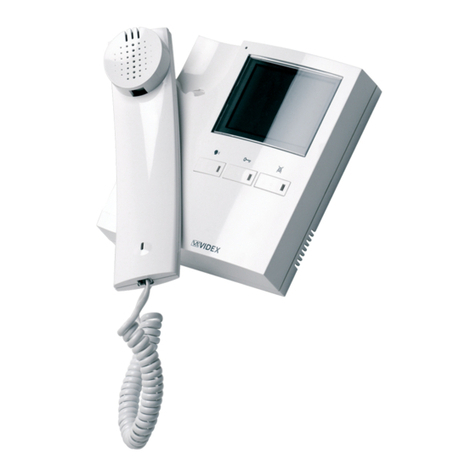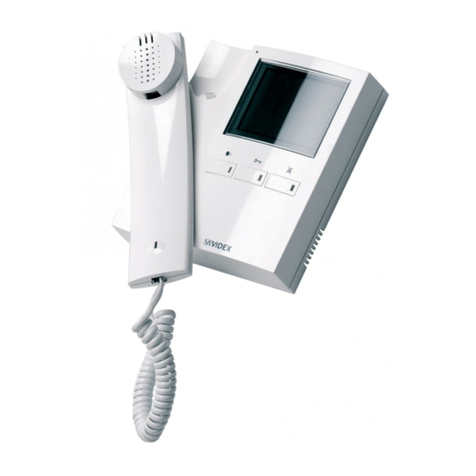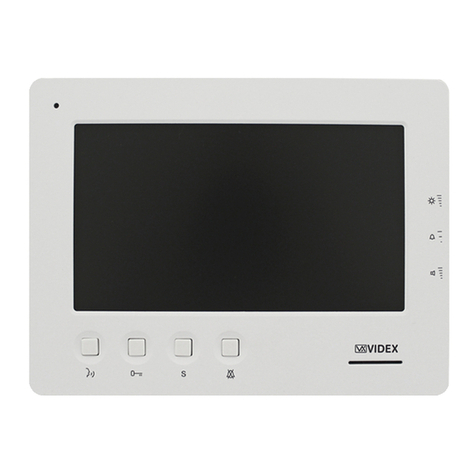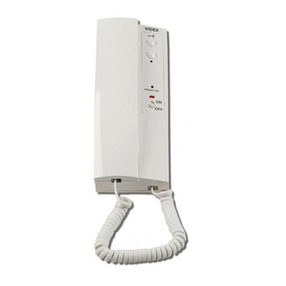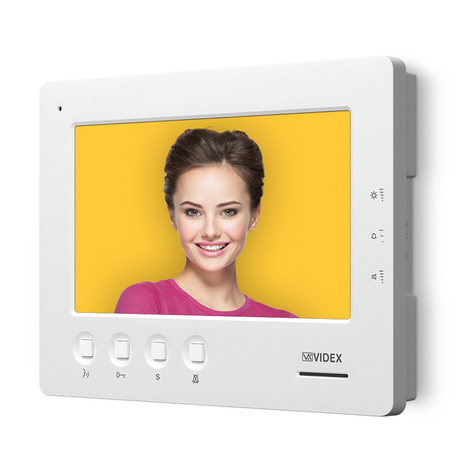VIDEX ELECTRONICS S.p.A. VX2200 “2 WIRE” Bus Digital System
61
ART.3371 E 3376 VIDEOCITOFONI DIGITALI SERIE
3000 PER SISTEMI VIDEO CON/SENZA COASSIALE
Descrizione
L’Art.3371, basato sul sistema videocitofonico BUS "6 fili", è un videocito-
fono digitale con 5 pulsanti di cui: uno apri-porta, uno di auto-accensione o
allarme (in base alla configurazione) più 3 pulsanti di servizio. La chiamata,
distinta tra locale e principale, è con nota elettronica e l’utente può regolarne
il volume su 3 livelli. Per la connessione del videocitofono al bus viene im-
piegata la scheda fornita a corredo della piastra di fissaggio Art.3980. Il vide-
ocitofono è dotato di un dip-switch ad 8 vie per la programmazione del suo
indirizzo fisico, di uno a 4 vie per l’impostazione del sistema video (coassiale
o non coassiale) e di un trimmer VR1 per la regolazione del volume microfo-
no (è possibile accedere ad i vari controlli nella parte posteriore del videocito-
fono). È possibile collegare nello stesso impianto fino a 180 videocitofoni
della serie 3000 ed è consentito (per tutte quelle applicazioni in cui occorre
avere più unità in un unico ambiente) assegnare lo stesso indirizzo ad un
massimo di 3 di essi (in tal caso è necessario alimentare uno dei 3 videocito-
foni localmente). Il pulsante apri-porta dell’Art.3371 è anche pulsante di
chiamata verso il centralino (se presente nell’impianto), il pulsante “n” può
essere programmato come pulsante di “auto-accensione” (impostazione stan-
dard) o di allarme (da utilizzare in presenza di un centralino di portineria o di
un Art.512DR configurato come scheda relè di servizio) ed i 3 pulsanti di
servizio chiudono tutti verso un contatto comune (morsetto 11 della scheda di
connessione, segnale “COM”). L’Art.3376 è simile all’Art.3371 con un pul-
sante di servizio in meno e delle funzioni addizionali:
-l’esclusione di chiamata, per l’attivazione del modo “privacy”, che avviene
premendo il pulsante . L’esclusione termina allo scadere del tempo impo-
stato tramite il relativo dip-switch a 3 vie o premendo nuovamente il pul-
sante di attivazione. Il led rosso “privacy on” segnala lo stato del servizio
(led acceso: il modo privacy è attivo e le chiamate non vengono ricevute);
-la segnalazione dello stato della porta d’ingresso data dal led “door open”
(led acceso, porta aperta – per l’utilizzo di questo servizio è necessario por-
tare fino al videocitofono un conduttore addizionale proveniente dalla porta
d’ingresso).
Entrambi i modelli di videocitofono consentono il collegamento della scheda
relè Art.402 (opzionale) per l’attivazione di una suoneria esterna al posto di
quella interna.
Funzionamento
In posizione di riposo:
L'unità è pronta ad accettare tutte le chiamate in arrivo;
Per rispondere ad una chiamata ed aprire la porta:
Sollevare la cornetta e parlare con il visitatore (o il centralino); premere il
pulsante "Chiave" (nel caso di chiamata da esterno) per aprire la porta op-
pure chiudere la conversazione riagganciando la cornetta; una eventuale
chiamata proveniente dal campanello locale si può distinguere dalla tonalità
che è diversa da quella della chiamata principale.
Per chiamare il Centralino (solo con centralino versione VX2210-1):
Con la cornetta agganciata premere il pulsante chiave ed attendere: la chia-
mata viene prenotata sul centralino e servita a discrezione dell’operatore;
Per attivare i servizi legati ai pulsanti ●●, S1 ed S2:
Premere il pulsante “●●”, “S1” o “S2” in base al servizio che si desidera atti-
vare (eseguire gli opportuni collegamenti per l’utilizzo dei servizi).
Per eseguire l’auto-accensione dell’impianto:
Sollevare la cornetta e premere il pulsante “●”, in rapida successione, tante
volte quanto è il valore dell'identificativo (1..10) del posto esterno da accen-
dere (se il posto esterno ha ID=3 premere 3 volte) e dopo circa 1s sarà attivo
il collegamento audio/video con il posto esterno selezionato. Ciascuna pres-
sione del pulsante “●” è confermata da un segnale acustico. Per utilizzare
questa funzione è necessario che il pulsante “●” sia opportunamente pro-
grammato e che il centralino di portineria, se presente nel sistema, sia in mo-
do off. Nel caso di sistemi su più livelli, l'auto-accensione opera sugli ingressi
principali.
Per attivare la segnalazione di allarme verso il centralino:
Premere il pulsante “●”. Questa funzione non può essere utilizzata se il rela-
tivo pulsante è configurato come pulsante di auto-accensione.
ART.3371 AND 3376 DIGITAL VIDEOPHONES 3000
SERIES FOR COAX/NON COAX VIDEO SYSTEMS
Description
The Art.3371 is a digital videointercom based on a “6 Wire BUS”, it in-
cludes 5 push buttons; a door-open button, an alarm or recall (depending on
the settings) button and three general purpose service push buttons. The call
is an electronic tone with a 3 level volume control which can be adjusted by
the user. The local call has a different tonality from the main call. To connect
the videophone to the “BUS”, use the PCB connector provided with the
mounting plate Art.3980. The videophone has an 8 way dip-switch to set the
PHONE ID, a 4 way dip-switch to set the video system (coax or non coax)
and a trimmer (VR1) to adjust the microphone volume; all accessible from
the rear side of the videophone. With the 3000 series it is possible to connect
180 videointercoms on the same system and if necessary it is possible to give
the same address to a max. of 3 of them (for all those applications that re-
quire more units for the same apartment, it is also necessary in this case to
power locally one videophone). The door-open push button on the Art.3371 is
also the “call to concierge” (if there is one installed on the system), the
“n” push button can operate as a camera recall button (default setting) or
as an alarm button (for use with the concierge or with an Art.512DR config-
ured as a generic service relay board) and the three service push buttons
close to a common contact (terminal 11 of the PC connection -“COM”)
The Art.3376 has one service button less than the Art.3371 but has some
additional functions:
- the “privacy mode” which is activated by pressing the push button, it is
signalled by the red led “privacy on” and its duration (except when the
push button is pressed again) depends on the 3 way dip-switch (accessible
from the rear side of the videointercom) settings.
- the visual indication of whether the door is open or closed given by the
green LED “door open”: to use this service, an additional wire is required
from a door contact to the intercom.
Both models of videointercoms allow the connection of an optional relay
board Art.402, for the activation of an external sounder instead of the inter-
nal one.
Operation
In stand-by mode:
The unit is ready to accept all incoming calls;
To answer a call and open the door:
Pick the handset up and speak with the visitor (or concierge); press “Key”
button (if it is an external call) to open the door (an acoustic signal will be
emitted and the door will be opened for the time programmed) or replace the
handset to end the conversation; if the call is local (local bell), the call tone
will have a different tonality from the main one.
To call the Concierge Unit (if present and only VX2210-1 version):
With the handset replaced, press the “Key” button and wait: the call is
booked on the concierge and will be answered at the discretion of the opera-
tor;
To activate the services relevant to ●●, S1 & S2 push buttons:
Press the “●●”, “S1” or “S2” push button depending on the service you need
to be activated (for the use of these services it is necessary to make the ap-
propriate connections).
To operate the recall:
Pick up the handset then quickly press the “●” push button as many times as
the ID value (1..10) of the outdoor station to switch on (for example if the
ID=3 press the button 3 times). After about 1s the videophone will be con-
nected to the selected outdoor station. An acoustic tone confirms each time
the “●” button is pressed. This function can be used only if the push button is
configured as a recall button; the concierge, if present, must be in OFF
mode. In case of multilevel systems, the recall facility will work with the out-
door station of the main level.
To send the alarm signal to the concierge:
Press the “●” push button. This function can be used only if this push button
isn’t configured as a recall one.
